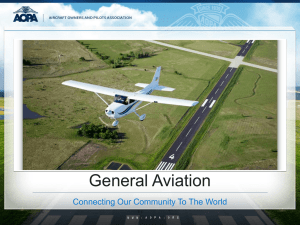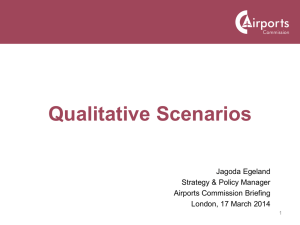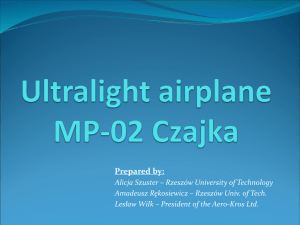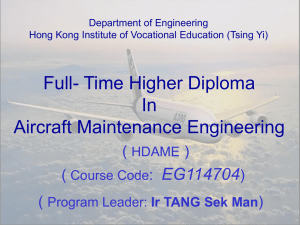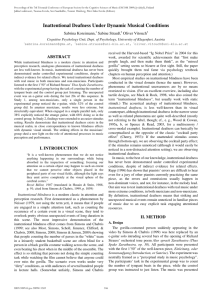FACTSHEET HUMAN FACTORS
advertisement
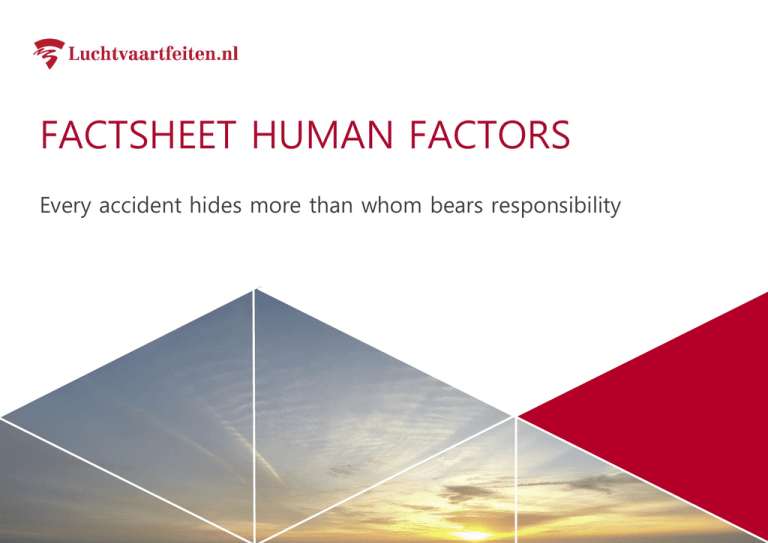
FACTSHEET HUMAN FACTORS Every accident hides more than whom bears responsibility Human Factors Factsheet Every accident hides more than whom bears responsibility Throughout the years human factors have become increasingly important in the aviation industry (Figure 2). Since the introduction of human factors, human errors have been appointed as one of the most common causes of aviation accidents (Example 1). Research found that human error is a symptom of trouble deeper inside a system. Investigations should avoid attributing blame and need to look beyond human error, taking into account the situation as a whole (Figure 1). In order to create an understanding of human factors in aviation, three groups of human factors are discussed in this factsheet. The first group consists of Human Limitations, which are internal factors that adversely affect (cognitive) performance. The second group consists of External Factors that adversely affect (cognitive) performance. Finally, the third group are Organizational Factors, external factors that to not directly affect cognitive performance. Old View Human error is a cause of accidents You must find people's: -Inaccurate assessments Example 1: September 17th, 2014 New View A vacation flight from Ryanair performed by a Boeing 737-800 from Leeds (UK) to Malaga (ES) was on final approach to Malaga intending to land on runway 13. Meanwhile a Boeing 737-800 from Jet2 was departing from the same runway. By the time the Jet2 aircraft was starting its roll the Ryanair aircraft reached the runway. The Ryanair aircraft performed a go around and both aircraft climbed out to a safe altitude. By this time the vertical separation between the aircraft was only 400 ft. The problem was resolved when the Ryanair aircraft made a 90 degree right turn. While the Jet2 aircraft continued the standard climb out. Human error is a symptom of trouble deeper inside a system To explain failure, do not try to find where people went wrong -Wrong decisions The CIAIAC investigated any possible errors by the pilots, air traffic controllers and other relevant factors that contributed to the incident. The CIAIAC concluded that a lack of communication between pilots and air traffic controllers, stress, fatigue, and a lack of awareness by air traffic controllers can contribute to similar events in absence of technical failures 1. -Bad judgements To explain failure, you must seek failure Instead, find out how people's assessments and actions made sense at the time, given the context Figure 1, The new view (Dekker, 2002) 1 Human Factors Factsheet 1996 Boeing introduces MEDA Since WW II Human Factor research has become a more profound part of aviation safety management. From the first flight control, flight operations, ergonomic and psychological research, to implementation of knowledge on the first jet aircraft in the 50’s, 60’s and 70’s. HF in accident analysis and the influence of HF on performance and safety remained a smaller part of research until the 1980’s. 1988 After Aloha 1977 After Spanish CAA research, the Air Line Pilots Association reinvestigated the accident to determine the influence of Human Factors. 1977 KLM FL4805 and Pan Am 1736 collision Tenerife Combination of conditions and miscommunication between KLM crew and ATC caused accident. FL243 the FAA was mandated to investigate the impact of Human Factors in nearly all areas in aviation and focus on the relation between modernization of systems and human factors. 1996-1998 Valujet FL592 prompted the FAA to start a second regulatory response in Human factor research. The new documentation focussed on adequately address HF issues in design, application of technology, systems, training, and procedures besides the growing relevance to maintenance. 1993-1994 FAA implemented its findings in Order 8300,10 of the Airworthiness Handbook, Titled ‘’Human factors Involved in Inspection and Repair in a Heavy Maintenance Environment.’’ 1988 Aloha Airlines FL243 1996 ValuJet FL592 Extreme decompression due to fatigue damage not noticed by maintenance program. Aircraft crashed due to improperly packed oxygen generators that caused fire. and PEAT (1999) to systematically investigate Human Errors (Factors), understand contributing causes in maintenance and flight crew procedural deviations, discover causes of incidents. 1999 Airbus introduces FSF, to encourage human factors research 2000 Airbus EGIS Human Factors Cockpit support Since 2005, FAA, EASA and national CAAs issue HF curriculum requirements in multiple aviation regulation documents. 2009 Integration of Human Factors into Safety Management Systems (CAAP). Figure 2: Evolvement of human factors in aviation 2 Human Factors Factsheet effect on complacent behaviour. For example after a 12 hour overnight flight, pilots become increasingly hesitant towards stimuli in the visual field, and response times increase. Potential dangers go unnoticed 5, 6, 7. In an attempt to prevent complacency researchers tested the effects of training. Training did improve overall performance, but had no effect on automation induced complacency 8, 9. Researchers do suggest that training on attention allocation strategies could mitigate complacent behaviour 10. Human Limitations Humans have their limitations. The performance of humans differ when they are exposed to factors such as stress. During an Air France flight from Rio de Janeiro to Paris in 2009 the aircraft stalled in mid-flight and crashed into the ocean. Although there were technical issues with the aircraft, it was the pilot’s reaction to the situation that led to a stall. Even though aural and visual stall warnings were presented, the pilot continued to pull the stick backward, indicating that the pilot was focused on increasing the altitude of the aircraft. Both pilots faced a number of human limitations resulting in the crash. Surprisingly these limitations are present during normal operations and can become critical even in a normal chain of events 2. Inattentional Blindness During everyday activities we seem to look without seeing every detail. A pilot focusing his attention on the gauges may fail to notice unsuspected objects on a runway when he looks through the windshield. This is called Inattentional Blindness. Focusing attention on one activity also increases the chance of being blind to changes: Change Blindness. Inattentional and Change Blindness are explained by the limited amount of data a person is able to process. During high demanding tasks there is less capacity left to process changes in the direct environment 11. Also age is a factor in Inattentional Blindness. Adults are less likely to encounter Inattentional Blindness compared to children and elderly. Inattentional Blindness, like Change Blindness and Inattentional Deafness, happens without being noticed by the person. Therefore it is hard to fight Inattentional Blindness. Only by the use of safety nets, such as a division between operational and monitoring tasks, can Inattentional Blindness be countered. Complacency Complacency is the uncritical satisfaction with oneself or one's achievements and can lead to overreliance on an automated system. The operator becomes less and less vigilant while monitoring 3. Complacency can occur when an operator is multitasking in a highly reliable automated environment and the operator blindly trusts the system 4. Fatigue has an Inattentional deafness Given the noise in the cockpit, it could occur that a pilot misses a warning sound or part of a conversation. This can occur during demanding tasks and is called Inattentional Deafness. The chance of suffering from Inattentional Deafness varies with the amount of attention needed for the main task 12. The chance of Inattentional Deafness is greater during a highly demanding visual task 12, such as landing an aircraft and watching the instruments. Inattentional Deafness can be reduced by assigning a clear division of tasks and frequent general checks 13. 3 Human Factors Factsheet Lack of assertiveness External factors Lack of assertiveness is a form of behaviour which occurs when a person is not self-confident enough to speak up for his or her rights and ideas. Researchers have shown that personality traits are determined by genetics: of all the children who were very shy and introvert 25% will not change this behaviour later in life 14. It has been shown that a gap in experience or differences in military rank (the trans-cockpit authority gradient) influences communicational behaviour. A steeper gradient is more likely to trigger passive behaviour 15. Although lack of assertiveness is a global problem, the impact can be correlated with the culture of the region. For example Japanese people tend to be more passive than Israeli 16. Assertiveness can be improved through group courses with role playing. The Tenerife accident on March 27th, 1977, a runway collision between a Boeing 747 of KLM and a Boeing 747 of Pan Am, led to one of the first investigations where the contribution of human factors was studied. 583 people died during the crash. Human factors related to this accident include stress and a lack of assertiveness. The stress of the KLM crew was initiated by their duty time. The hierarchy in the cockpit of KL4805 adversely affected the first officer’s assertiveness, making him reluctant to question the captain’s decision to take off 19. The former shows that human performance and judgement can be affected by external factors that lie beyond influence and character of the individual. Lack of communication Lack of awareness Lack of communication is a failure to transmit, receive, or provide enough information to complete a task. Maintenance engineers, ground handlers, air traffic controllers and pilots are as susceptible as anyone to unknowingly submit to lack of communication. Lack of communication occurs when people wrongly assume certain things have already been done or said 20. One method to prevent a lack of communication is by using a safety net to never assume a thing, always check with colleagues, and always build in feedback. Besides this, important information should always be written down so it cannot be forgotten 21. Situation(al) Awareness is stated as “the perception of the elements in the environment within a volume of time and space, the comprehension of their meaning and the projection of their status in the near future” 17. A lack of Situation Awareness has been implicated in 85% of all human factor incidents 18. Situation Awareness is obtained by scanning the environment and comparing the gathered results with mental models. Therefore, aspects as communication, coordination, objective setting and feedback are essential. Situation Awareness is lost by distraction, inattention and high workload. Loss of Situation Awareness is prevented by implementing proven best practices, following ICAO recommendations and company’s Standard Operating Procedures (SOPs). Fatigue Fatigue is physical and/or mental exhaustion 22, resulting in a decrement of performance. Fatigue occurs in aviation due to irregular working hours and long duty periods leading to circadian disruptions and insufficient sleep. Pilots nap an average of between 1.8 and 3.7 hours of sleep on long-haul flights 23. Fatigue studies show that besides permitted naps, sudden shifts between wakefulness and sleep lasting a fraction of a second up to 30 seconds (microsleep) do occur in the cockpit. These microsleeps particularly happen on long-haul flights during low-work periods. It is quite possible that these microsleeps occur with both pilots at the same time, 4 Human Factors Factsheet leaving the aircraft effectively uncontrolled. Pilots do not always notice their level of fatigue, and may doze off repeatedly while believing to have “successfully avoided the physiological realities of severe fatigue” 24. Stress Stress is the subconscious response to the demands placed upon a person 3. Excessive stress leads to overburdening of abilities and decreases human performance 25, 26. However, too little activation or arousal, which can be seen as a low stress level, entails boredom which also leads to decreased performance 27. Work related stressors can be tight deadlines, innovation, (lack of) social support, work that requires a high attention level, or repetitive tasks. Stressors can also alight from personal life: the passing away of a family member or divorce 28, 29, 30. Stress management techniques include relaxation techniques, careful regulation of sleep, a healthy diet, and counselling. Distraction Distraction occurs when our attention is shifted away from the original focal point. It is possible to discriminate four types of distraction: visual, auditory, manual and cognitive distraction 18.. Distraction occurs because our mind works much quicker than our hands and therefore we are always thinking ahead 3, and depends on personality, physical circumstances and the environment 31. Distractions can be countered by using a safety net consisting of a few points to remember when working on a task, a detailed check sheet at completion, marking any uncompleted work, and always going back three steps when you return to the job. Let somebody else inspect the work when it is finished, or double check it yourself 32. Training may also help 3. Organizational factors During a Ryanair flight from Stockholm to Madrid on July 26th, 2011, the aircraft had to divert due to thunderstorms. The pilots reported to ATC that there was insufficient fuel to reach Madrid and had to land at Valencia. Before the flight Ryanair introduced a new system to calculate the amount of fuel required for a particular flight in order to increase fuel efficiency. Pilots are always able to add extra fuel but should try to minimize the amount of excess fuel. In this case the incident could have been prevented by both pilots and management. Also the lack of resources regarding the weather was involved in the incident. The human factors involved in this incident did not affect human performance, but adversely affected safety by imposing a restraining environment. 5 Human Factors Factsheet Lack of teamwork Lack of teamwork is defined as the presence of interdependent individuals who do not work together or communicate well with others to achieve a common set of goals 21. Lack of teamwork is caused by individuals that do not communicate to their team members and/or do not know what their roles and responsibilities are. Moreover, lack of teamwork can be caused by taking individual rather than group decisions 21. Through the use of standard operating procedures and formal training such as crew resource management, commercial aviation regulations attempt to prevent accidents where lack of teamwork is involved. Norms “Norms is short for ‘Normal’, or the way things actually are done around an organization 3. They are unwritten rules followed or tolerated by the majority of a group. Negative norms are those that detract from an established safety standard. This kind of human error occurs mainly because of the following points: routine work, alternative norms made by employees, functioning in a non-approved manner. The points become unofficial norms when they remain in the organization for an extended period of time. In the end, management tolerates the norms that are made by the employees 21. Countermeasures can be to never use shortcuts, be aware of your own bad habits, emphasize positive things to eliminate negative things, and be an example for other people. Finally, it is managements role to correct employee behaviour directly when it is contrary to safety 21. Lack of knowledge A lack of knowledge indicates that one does not have the knowledge, skills or experience to perform the job 34. For instance maintenance procedures on aircraft must be performed in accordance with standards specified by aircraft manufacturers, airlines or authorities (FAA, EASA and ICAO). Changes in these procedures occur regularly. Management should invest in regular training in order to keep employees up to date with the quickly changing environment in aviation 35. Also the latest manuals must be available to make sure that the right procedures are executed, and one should ask help from others when something is unclear 34. Lack of resources Pressure Resources are any tools or materials required to maintain and/or inspect aircraft. In order to prevent accidents due to a lack of resources, equipment has to be ordered before it is required and the available sources for equipment have to be known to arrange pooling or loaning. Furthermore, the time schedule to complete an aircraft maintenance task must be sufficient 33. Pressure may be expected when working with various people and systems. It is only when pressure builds to a certain level and stands in the way of completing the necessary task timely and correctly that it becomes a threat to safety. The most common form of pressure is time pressure 36. Research shows that time pressure causes people to take more risks and more likely make decisions based on heuristic recognition than use available knowledge 6 Human Factors Factsheet 37, 38 . Task difficulty and the available time need to be well regulated in procedures to make sure employees are not under any kind of pressure when performing the task. Organizational aspects like working hours should be taken into account when designing solutions to reduce incidents and accidents in aviation. References 1 CIAIAC (2014). Incident on 17th September 2014 to the Boeing 737-800, registered EI-EB and Boeing 737-800, registered G-GDFR, at Malaga Airport. 2 Bureau d’Enquête d’Analyses (2012). Final Report on the Accident on 1st June 2009 to the Airbus A330-203, registered F-GZCP, operated by Air France, flight AF 447 Rio de Janeiro – Paris. 3 Dupont, G. (1997). The dirty dozen errors in aviation maintenance. In Meeting Proceedings Eleventh Federal Aviation Administration Meeting on Human Factors Issues in Aircraft Maintenance and Inspection: Human error in aviation maintenance (pp. 45-49). Washington, DC: Federal Aviation Administration/Office of Aviation Medicine. 4 Corver, S. C., & Aneziris, O. N. (2014). The impact of controller support tools in enroute air traffic control on cognitive error modes: A comparative analysis in two operational environments. Safety Science, 5 Russo, M.B., Sing, H., Santiago, S., Kendall, A.P., Johnson, D., Thorne, D., Escolas, S.M., Holland, D., Hall, S., Redmond, D. (2004). Visual Neglect: Occurance and Patterns in Pilots in a Simulated Overnight Flight. Aviation, Space and Environmental Medicine (ASEM), 75(4), 323-332 6 Petrilli, R. M., Roach, G. D., Dawson, D., & Lamond, N. (2006). The sleep, subjective fatigue, and sustained attention of commercial airline pilots during an international pattern. Chronobiology international, 23(6), 1357-1362. 7 Hartzler, B. M. (2014). Fatigue on the flight deck: The consequences of sleep loss and the benefits of napping. Accident and Analysis Prevention, 62, 309318. 8 Singh, I. L., Sharma, H. O., & Parasuraman, R. (2001). Effects of manual training and automation reliability on automation induced complacency in flight simulation task. PSYCHOLOGICAL STUDIES-UNIVERSITY OF CALICUT,46(1/2), 21-27. 9 Singh, A. L., Tiwari, T., & Singh, I. L. (2009). Effects of automation reliability and training on automation-induced complacency and perceived Nobody goes to work to do a bad job People who consider an event after it has occurred often claim that they would easily have been able to predict the event in advance if they had been asked to do so 39. The complete scenario is often overlooked and investigations regularly point at human factors as the cause, while human factors often have an underlying cause. The human error is not an explanation for failure, but instead demands an explanation 40. Investigations should not focus on attributing blame. Instead one should ask why it made sense to make a mistake 41. The investigation of factors that easily disappear behind the label “human error” should thus be encouraged. After all, “Nobody goes to work to do a bad job” – William Edwards Deming. 7 Human Factors Factsheet 10 11 12 13 mental workload. Journal of the Indian Academy of Applied Psychology, 35 (Special Issue), 9-22. 20 Shorrock, S. T. (2007). Errors of perception in air traffic control. Safety science,45(8), 890-904. Parasuraman, R., & Manzey, D. H. (2010). Complacency and bias in human use of automation: An attentional integration. Human Factors, 52(3), 381-410. doi:10.1177/0018720810376055 21 Peterson, J. (2011). Dirtydozen. Retrieved October 9, 2014 22 The Free Dictionary - Fatigue. (n.d.). Retrieved from The Free Dictionary: http://www.thefreedictionary.com/fatigue 23 Roach, Darwent, Sletten, & Dawson. (2010). Long-haul pilots use in-flight napping as a countermeasure to fatigue. Elsevier, 214-218. 24. Caldwell. (2004). Travel Medicine and Infectious Disease. Elsevier, 85-96. 25 Arshadi, N., & Damiri, H. (2013). The relationship of job stress with turnover intention and job performance: Moderating role of OBSE. Procedia - Social and Behavioral Sciences, 84(0), 706-710. 26 Cowan, R., Sanditov, B., & Weehuizen, R. (2011). Productivity effects of innovation, stress and social relations. Journal of Economic Behavior & Organization, 79(3), 165-182. Lavie N, Hirst A, de Fockert J. W. & Viding E. (2004). Load Theory of Selective Attention and Cognitive Control. Journal of Experimental Psychology Vol. 133, No. 3, 339–354 S.P. Macdonald, J., & Lavie, N. (2011, May 25). Visual perceptual load induces inattentional deafness. Retrieved from Springer: http://link.springer.com/article/10.3758%2Fs13414-011-0144-4 Cartwright-Finch, U., & Lavie, N. (2007). The role of perceptual load in inattentional blindness. Cognition, 102(3), 321-340. 14. Kagan, S. (2011). Kagan cooperative learning. California. Kagan Publishing. 15 Chua, R.Y.J., Iyengar, S.S., (2011). Perceiving freedom givers: Effects of granting decision latitude on personality and leadership perceptions. The Leadership Quarterly, 22(5), 863-880 27 Cowan, M., Davie, A., & Migaud, H. (2011). The effect of metal halide and novel green cathode lights on the stress response, innate immunity, eye structure and feeding activity of Atlantic cod, Gadus morhua L. 16 Zimbardo, P. G. (1990). Shyness: What it is, what to do about it. Da Capo Press. 28 Cowan, M., Davie, A., & Migaud, H. (2011). The effect of metal halide and novel green cathode lights on the stress response, innate immunity, eye structure and feeding activity of Atlantic cod, Gadus morhua L 17 Endsley, M.R. & Garland, D.J. (2000). Pilot situation awareness training in general aviation. In proceedings of the 14th triennial congress of the international ergonomics association and the 44td annual meeting of the human factors and ergonomics society. Santa Monica, CA: HFES. 29 Saldana, Rodriguez, & Ritzel. (2012). Influence of task demands on occupational stress: Gender differences. Elsevier, 365–374. 30 García-Herrero, S., Mariscal, M. A., Gutiérrez, J. M., & Ritzel, D. O. (2013). Using bayesian networks to analyze occupational stress caused by work demands: Preventing stress through social support. Accident Analysis & Prevention, 57(0), 114-123. 31 Young, K., Lee, J. D., & Regan, M. A. (2009). Driver Distraction: Theory, Effects, and Mitigation. Taylor & Francis Group, LLC. 18 ATSB, A. T. (2004). Dangerous Distraction; an examination of accidents and incidents involving pilot distraction in Australia between 1997 and 2004. Australian Transport Safety Bureau. 19 Airline Pilots Association, (1977). Human Factors Report on the Tenerife Accident. Retreived from Skybrary: http://www.skybrary.aero/bookshelf/books/35.pdf 8 Human Factors Factsheet 32 Marss. (2009). The "Dirty Dozen" in Aviation Maintenance. Opgehaald van Aviation Knowlegde : http://aviationknowledge.wikidot.com/aviation:dirtydozen 33 Concetti, M., & Fedele, L. (2011). 2. Safety in Maintenance: errors and human factors. Healthy Workplaces, 11. 34 Airplane Flying Handbook. (2004). U.S. Department of Transportation Federal Aviation Administration. 35 Taylor, D. (2012). Retrieved from AviationLearning.net: http://www.aviation-training-consultants.com 36 Image references (top to bottom, left to right) 1 39) Dekker, 2002 Koslowsky, M., Kluger, A.N., Reich, M., 1995. Commuting Stress: Causes, Effects, and Methods of Coping. Plenum, New York. 2 http://classicwings.nl/crew-resource/ Hilbig, B.E., Erdfelder, E., Pohl, R.F., (2012). A matter of time: Antecedents of one reason decision making based on recognition. Acta Psychologica, 141(1), 9-16 3 www.marss.org/posters/D2.html 4 transair.co.uk/products/images/large/oat_atpl_humanperform2.jpg 38 Young, D. L., Goodie, A. S., Hall, D. B., & Wu, E. (2012). Decision making under time pressure, modeled in a prospect theory framework. Organizational Behavior and Human Decision Processes, 118(2), 179-188. 5 http://www.davegranlund.com/cartoons/wp-content/uploads/piloterror-report-web.jpg 39 Guilmette, T.J., Hart, K., (1988). Eliminating the Hindsight Bias. Journal of Applied Psychology, 73(2), 305-307 40 Dekker, S.W.A. (2002). Reconstructing human contributions to accidents: the new view on error and performance. Journal of Safety Research, 33(1), 371385Arkes, H.R., Faust, D., 37 41 Dit is een uitgave van: Luchtvaartfeiten.nl Overnemen van teksten is toegestaan. Graag bij citeren vermelden: ‘Luchtvaartfeiten.nl (2014), Factsheet Human Factors, ‘www.luchtvaartfeiten.nl’ Luchtvaartfeiten.nl is een initiatief van de HvA Aviation Academy. Studenten en docenten delen kennis met politiek en publiek, om te zorgen voor een discussie op basis van feiten. Leveson, N. G. (2012). Engineering a safer world: Systems thinking applied to safety. The MIT Press. Retrieved from http://rps.hva.nl:2307/book/id_47540/book.asp Oktober 2014 9

